
While there are several ways to leach acorns, cold leaching is the best way to create a versatile end product that can be used as a fine flour or coarse polenta. Acorn flour doesn’t have gluten in it, so it won’t rise on its own. That’s why you often see recipes call for half acorn flour and half regular flour. But some baked goods, like cookies and brownies, work well with cold-leached acorn flour alone. Acorn flour adds richness and depth to anything you use it in.
Hot leaching cooks the starch in the acorns (making them suitable for soups and grits), so baked goods made with hot-leached flour may fall apart. Cold leaching preserves the starch that helps bind your baked goods, so if you like to bake, cold-leaching is the way to go.
You have choices when it comes to cold-leaching acorns. Here are three methods, all of which work well. The main difference is how much time it takes to get the job done.
The Lazy Way to Cold Water Leach Acorns
Native peoples used to let running water do the work of leaching by tethering baskets of acorns in a stream and allowing the cold water to run through the nuts for several days. I don’t have a stream, but I do have a toilet tank.
The easiest way to cold leach acorns is to stash them in the back of your toilet. To be clear: I’m talking about the toilet tank, not the toilet bowl. Empty the toilet tank, scrub it, then refill it with clean water. Put your shelled acorns in a fine mesh bag and place the bag into the toilet tank. Each flush runs cold water through the nut meats, leaching them of their bitterness. Taste test at intervals after 24 hours. You may need as long as two to three days, depending on how often you flush.
For long term storage, dry your leached acorns in a dehydrator on the lowest possible temperature. You must keep the temperature below 150F to avoid cooking the starch. If you don’t have a dehydrator with a temperature setting, set it to low. If you don’t have a dehydrator at all, you can dry your acorn meal in an oven or warming drawer, as long as the temperature is below 150F. The nuts are fully dried when they are brittle and can be broken in half with a snap.
Red oak acorns require an extra step at this point. All acorns have a thin, papery skin called a testa, located between the nut meat and the shell. The testas of white acorns adhere to the shells, but the testas of red acorns stick to the nuts. Hot leaching removes the testas, which may have a bitter taste. If you cold leach, you’ll need to rub off the testas before you cook with your acorns. Fortunately, after drying, the testas fall away with a gentle rubbing.
Dehydrated, leached acorns can be ground into flour right away, or stored whole. In any case they should be sealed and stored in the freezer. Acorns are high in fat, which may turn rancid if stored at room temperature.
The Jar Method for Cold Leaching Acorns (still pretty easy for a lazy forager)
If the idea of using the toilet makes you uncomfortable, try the jar method. It’s low tech, and requires only a little more effort on your part. For this method, you’ll need to grind your shelled acorns into a coarse meal before leaching. You can do this in a high quality blender, like a Vitamix, or with a hand mill, sold for grinding whole corn kernels. A hand mill produces a coarse grind, which is perfect for recipes like falafel and veggie burgers, while the Vitamix produces a finer flour, excellent for baking.
Find a large, clear glass or plastic jar with a tight-fitting lid. Fill the jar halfway with coarsely ground acorn meal, then top it off with tap water. Use a chopstick or the handle of a wooden spoon to poke out any air pockets in the acorn meal, close the lid, and give the jar a good shake. Move the jar to the refrigerator. The acorn meal will settle out of the water with time, and the water turns brown as the tannins leach from the nuts.
Let the jar sit for 24 hours in the refrigerator, then carefully pour the water off the meal. Don’t worry about getting every last drop. Refill the jar with water, and replace the jar in the refrigerator. You’ll need to do this several times, depending on how bitter the nuts were to begin with. After pouring off the water for the third time, taste the acorn meal. If it’s bitter, continue to change the water every 24 hours until no trace of bitterness remains.
Once the bitterness has been leached from the acorn meal, pour the meal out into the center of a dish towel. Gather the four corners of the towel together and twist the dish towel closed, then continue to twist until water begins to drip from the bottom of the dish towel. When no more water can be removed by twisting, squeeze the dish towel as hard as possible to remove as much water as you can.
You can dry and freeze the acorn meal, or freeze the wet acorn meal. If you do the latter, you’ll need to adjust the liquid in any recipe you use it in.
The Fastest Way to Cold Leach Acorns
If you’re in a big hurry for leached acorn flour, try the running water method. This is the most labor-intensive method, but is by no means difficult. Put a cup of shelled nuts in a blender and add water to four to five inches above the level of the nuts. Pulverize to create a slurry, and set aside. (If you have already ground your acorns into meal, but not yet leached them, you can also use the method described below.)
Place a large colander in the sink and line it with a dishtowel. Pour the slurry or meal into the colander, then run cool water into the colander and stir with a large spoon. After eight minutes of stirring, taste the slurry. If there is any bitter flavor, let the water run for another two or three minutes and taste again. You should be able to stir without spilling, which is why this is best done in small batches in a large colander. Once the acorn meal is not at all bitter, squeeze out as much excess water as possible, as described in the jar method, above.
You can freeze the moist acorn meal as is, but you’ll need to use slightly less liquid in any recipe you make with the flour. I prefer to fully dry the flour before sealing it for long term storage.
If you have a dehydrator with fruit leather sheets, spread the moist acorn meal across the sheets and set the temperature to the lowest possible setting. Depending on the humidity where you live, your meal will take between 12 and 24 hours to dry. Check it after several hours and break up any large clumps to speed the drying process. An oven or warming drawer will also work, as long as the temperature is below 150F.
You can stop here, at the dried acorn meal stage, or grind it to make a fine flour for baking. The dry grains canister of a Vitamix does a great job in under a minute, but an ordinary spice grinder also does a very good job, albeit in smaller batches. I like to keep jars of both coarse meal and fine flour on hand.
Once the acorns (whole or ground) have dried, they’re ready to be measured, sealed, and stored. A vacuum sealer is a handy tool for preserving freshness, but if you don’t have a vacuum sealer you can store your leached acorns in ziplock bags. Close the bags most of the way, then suck out as much air as you can with a drinking straw before sealing them all the way.
Whole nuts will keep for several years in the freezer; the smaller amount of exposed surface area means slower oxidation. Flour and meal should be used within a year.
Ready to bake? Try this Steamed Acorn Brown Bread or these Acorn Lace Cookies.
This article was originally published in Backwoods Home magazine. (Nov/Dec 2016)
Note: I’ve written about the gelatin method for cold leaching acorns, but I’m not convinced it’s worth the work. I’d love to hear from anyone who’s tried it.
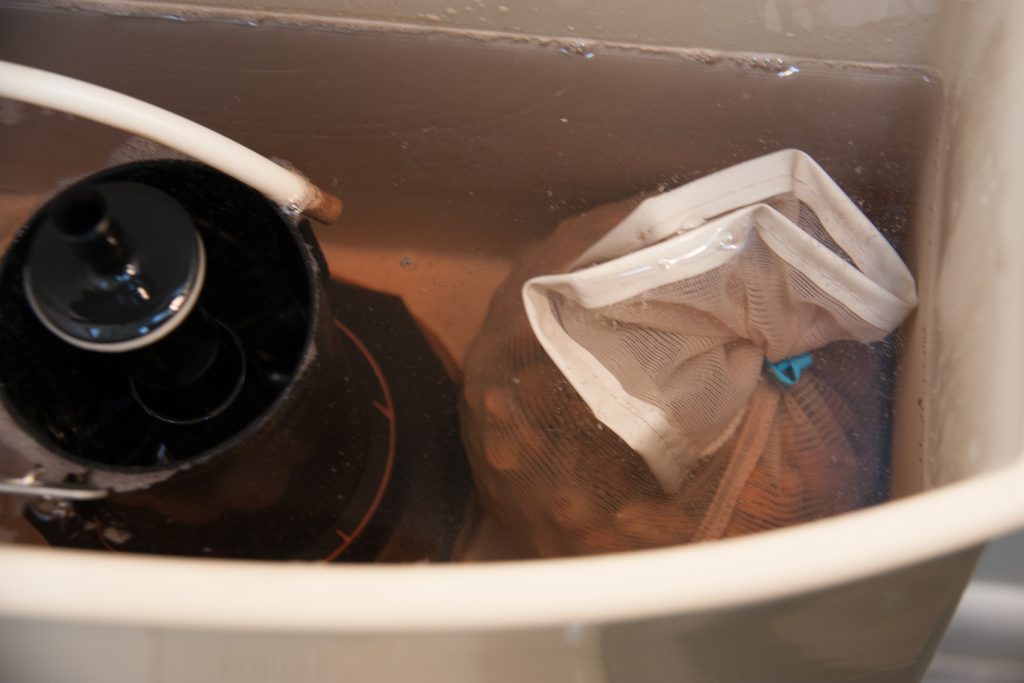
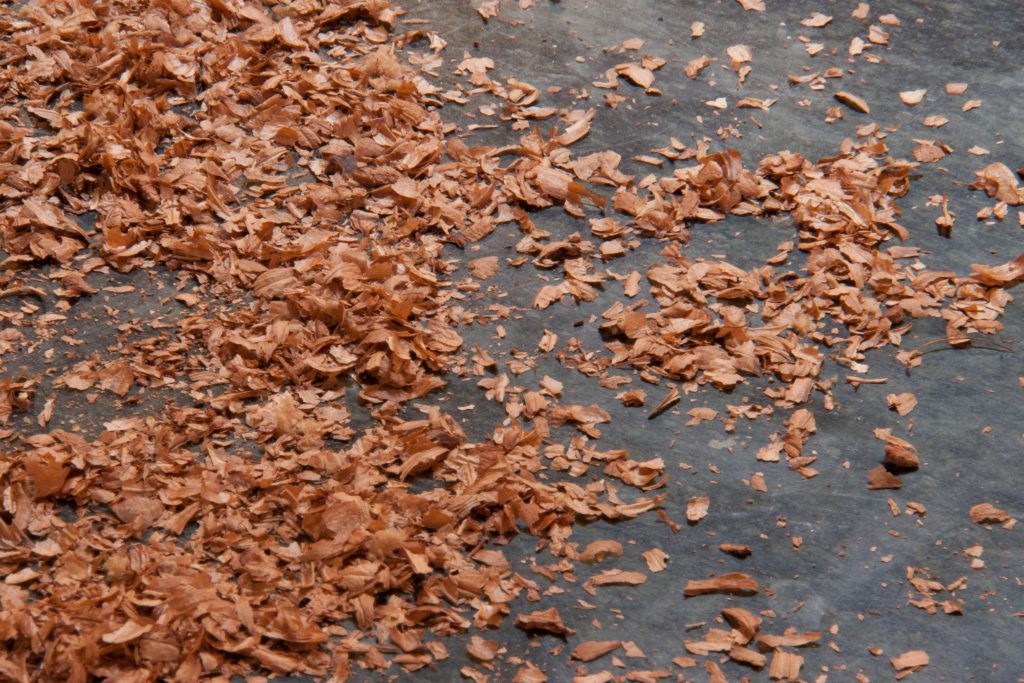
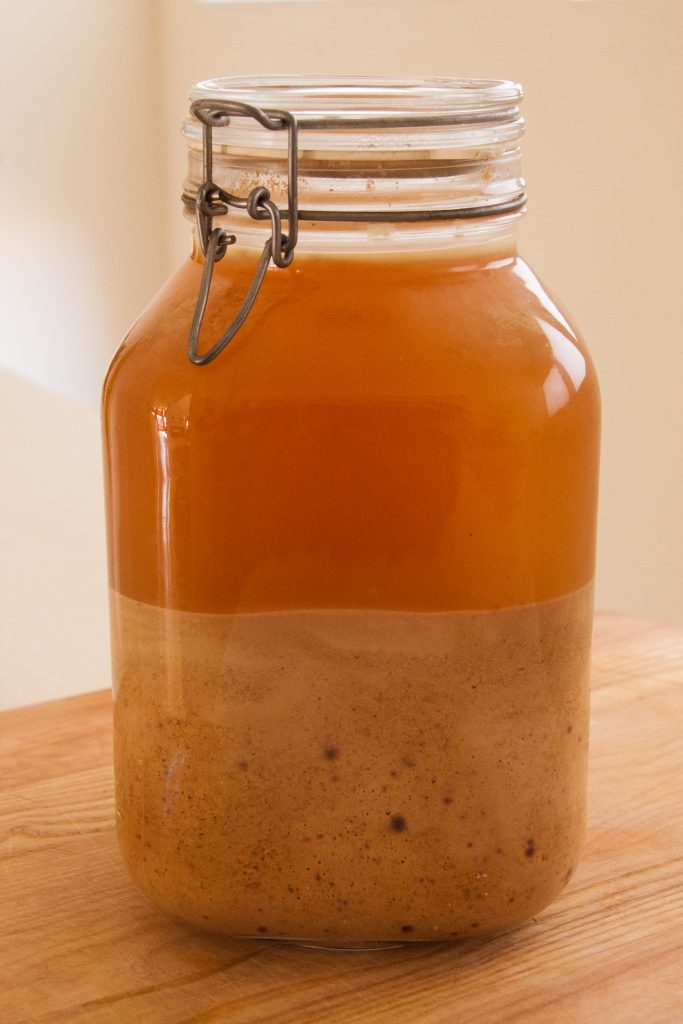
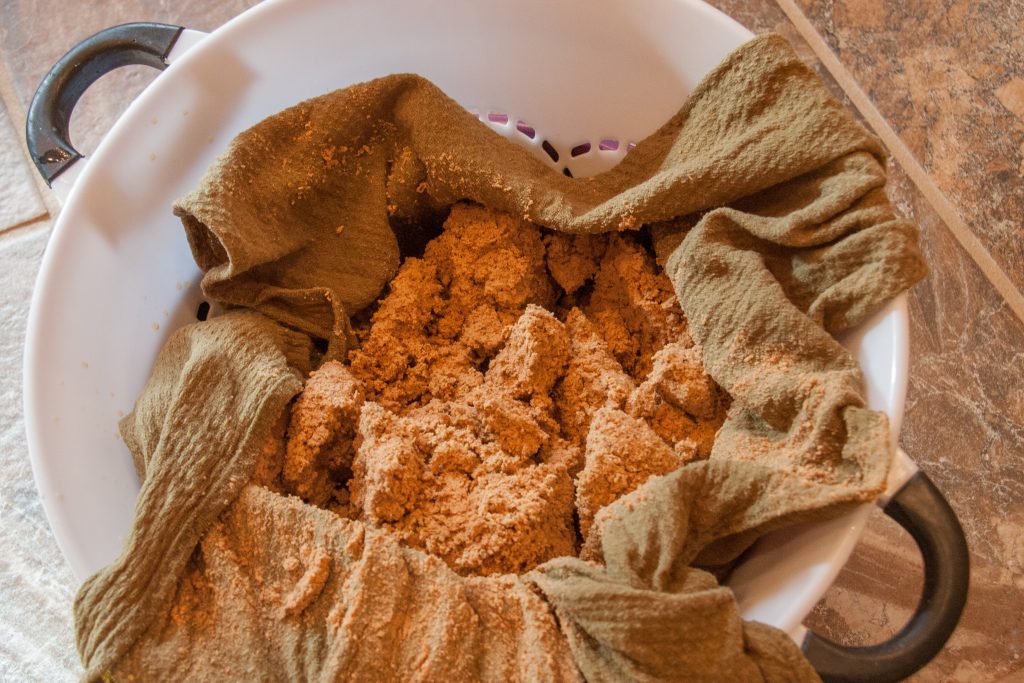
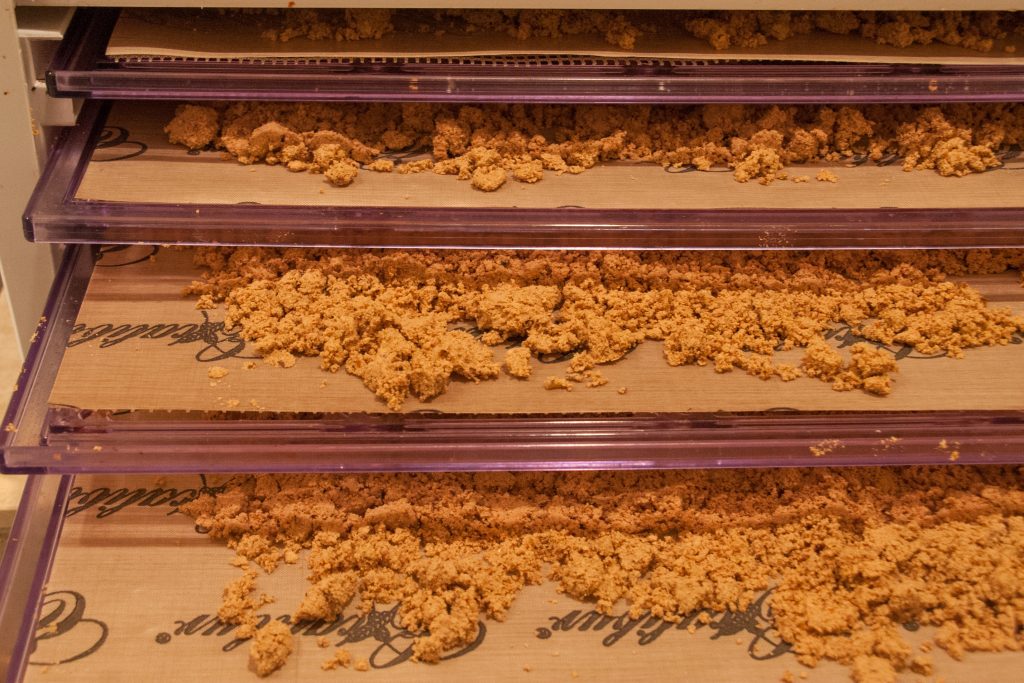
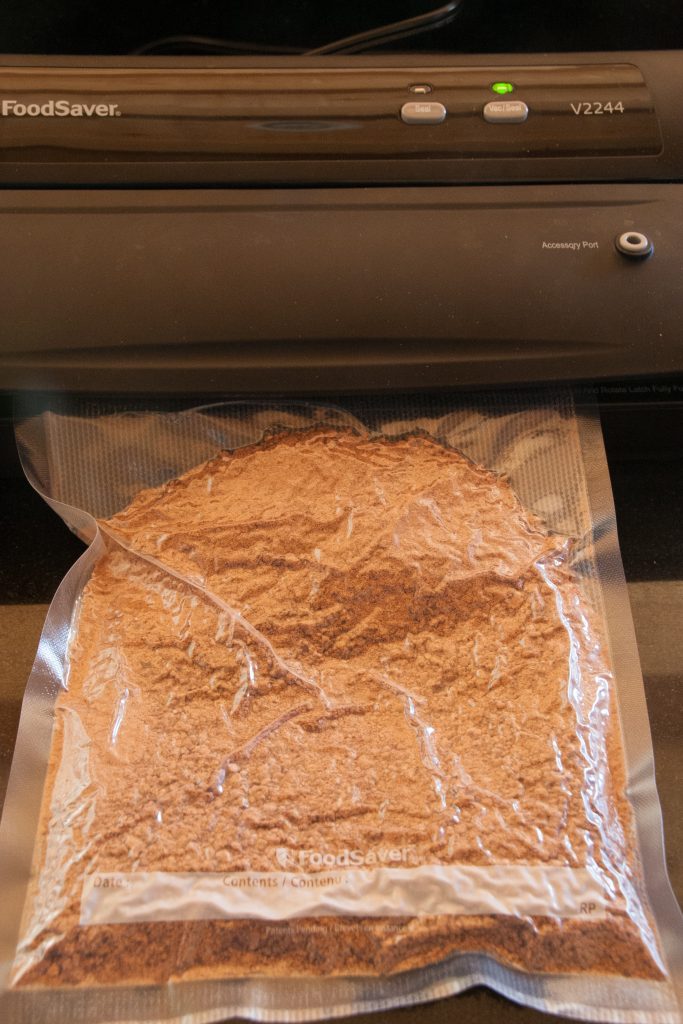
That said, even sweet acorns should be leached to remove what tannins exist in them because several studies show that unleached acorns can make you constipated and can harm your teeth.
Interesting! I’d love to read those. Can you share titles or links?
This is a good way to leach acorns without using fuel for boiling water, and you do not denature a particular starch in the acorns that acts a little like the gluten in flour, i.e.
I’m doing the cold leaching in a jar method. For the first few water changes, the water was dark but clear. After that, the water stayed cloudy.. What’s up with that? I used a Vitamix to make the acorns very fine.
Thanks!
Don’t worry about the cloudiness, Andrea, those are probably the acorn starch particles in suspension. A small amount of starch is released when you grind the acorns. Some people separate the starch from the flour and use it to make puddings and pie filling, but you need a very fine filter for that, like the kind used to filter maple syrup. I keep the all the solids together. Since acorn flour doesn’t contain gluten, it doesn’t stick together like wheat flour, but the starch gives it some binding ability. Have you tasted the flour? How’s the flavor coming along?
Thanks! It’s still pretty bitter, but I’ve only been leaching for a couple days. I’ll keep at it!
Andrea asked the following question about toilet tank cold leaching: “Do you chop the acorns into pieces for tank leaching or leave them more or less as they come out of the shell?”
When I cold-water leach in the toilet tank, I leach large pieces. Sometimes they’re whole, sometimes they’re halves or quarters. However they come out of their shells is how I leach them and how I dry them. I don’t grind them until I need to use them, and then I’ll grind either fine (for flour), medium (for grits), or large (for nuts).
When I cold leach in a jar, I grind the nuts fine prior to leaching.
Thanks, Ellen! How many days do you usually leave your acorns in the tank? I know it depends to some extent on how often one flushes, but I was wondering what you typically experience.
It also depends on what kind of acorns you’re leaching. Red oak acorns generally contain more tannins than white oak acorns, and take longer to leach. Typically, with two people in the house, it usually takes me 4-7 days to leach white oak acorns. But really, the only way to know when your acorns are done is to taste them.
I just put the shelled nutmeats in a mesh bag and let it soak in a big tub of water on the back porch. Every morning I pour it out and fill up from the hose until the water’s no longer yellow brown.
Guess I’m doing it wrong…
Nothing wrong with that! Sounds like an excellent method. It’s been too cold here recently, but for people who live where the water wouldn’t freeze, it’s a great idea.
Wondering what the health risks of stream leaching are…I wouldn’t drink water from the stream without treating it so would I be ok leaching acorns?
I’ve never done it, but I THINK it would be fine, because: 1) After leaching acorns I dry the nuts to preserve them, which removes the water from the nuts. 2) Stream leaching is cold leaching, so I’m guessing you’d be using the acorns for flour. In which case you’d be baking the acorns and the high temperatures would kill whatever organism you’re concerned about. If you’re worried about chemical pollution, I’m sorry, but I don’t know enough to address that.
I agree with Ellen that the microbial risks (e.g., Giardia) will be abated by drying and cooking; however, the pharmaceutical/toxic risks remain. Medications (e.g., endocrine disruptors) and toxins such as arsenic, mercury and lead can be in the water, depending on your location. I wouldn’t do it. I did try the toilet tank method, but we’re on well water so it’s not chlorinated and I got some algae growth (which isn’t a big deal, but I opted for just doing a couple jars in the refrigerator). Toilet tank would probably be safer than a stream.
Thank you Andrea, you said it better than I did. Pharmaceutical/toxic is what I meant by chemical. I started out with the toilet tank method when we lived in PA and were on well water. I never had any algae growth, but I, too, now use the refrigerator jar method. If I’m in a hurry, I do the pour through/stir method.
Well informed article and conversations on acorn nut leeching. I’ve always wanted to know how to utilize the acorn as a food source having grown up in an oak tree rich environment and thinking what do the squirrels know about the acorn that I don’t.
Glad to help, Keith. Let me know what you make first!
Great article, however I am confounded to get the testa off the nutmeat. Will leaching reduce the bitterness of those as well? I have been cold leaching mine for 10 days now, and they are still very bitter. Thanks in advance
Hi Liam, Don’t be discouraged! You may have found acorns with a high level of tannins, but you can still get rid of them, it just may take a little longer. I’m guessing you’re trying the toilet tank method, is that right? Have you noticed any decrease at all in the bitterness after ten days? How often are you flushing your toilet? The testas will some off easily once you dry the acorns. It’s much harder to remove them when the nuts are wet. Do you have a dehydrator?
I have some questions. I’ve been cold leaching some acorn nut meats in some glass jars for about 9 days (I started leaching them Sunday evening, November 10, 2019). My first question is this. Should I have the lids off? The lids have been on all that time, but water’s starting to smell odd.
My second question is this. Can I wash mold off the dry acorn nut meats that haven’t been leached? They were sitting in an open container, waiting to be leached. There’s still barely any mold, but I hope I can clean those acorn nut meats rather than throw them out.
Hi Brian, I’m happy to help, but I need a more info. Are the cold-leaching acorns whole or ground? Have you been changing the water, and if so, how often? As for your second question, I guess the acorns weren’t thoroughly dried before you put them in the jar. I’d like to see a photo of the moldiest acorn. Hopefully you can wash off all the mold, then dry the nuts thoroughly before storing, but I’d like to see how much mold there is before I say for sure. You can post the photo on my FB page: https://www.facebook.com/thebackyardforager/.
Hi, Ellen. Most of the acorns that have been leaching are in pieces because only a small percentage of them stayed whole when they were pried out of their shells.
At first, I was changing the water 2 or 3 times a day (that was for most of the 9 days). On the seventh day, the acorn nut meats went a whole day without the water getting changed, and yesterday (Monday, November 18th), I only changed the water once. I started changing the water less frequently because it started taking a lot longer to get colored by the tannic acid.
Two other possibly important facts are the following. First, I left the skins on the all the acorn nut meats ’cause it was too difficult to remove them when they were dry. I plan(ed) on removing them after draining the nut meats and dehydrating them in the oven at <150⁰F. Secondly, the slightly moldy acorn nut meats were put in an open, plastic container. That container has several times the nut meats' collective volume of air between them and a screened lid that was air drying on top of the opening to the container (I use that screened lid when draining the water from the glass jars of the "leach water").
I don't know how to attach photos to posts on this blog, so I'll just e-mail them to you.
Hi Brian, I answered you via email.
Hi Ellen, I just found your page after doing a trial run on processing some red acorns. I’ve only done 2 cups as this is my first attempt. I didn’t know anything about removing the testas. I did a coarse grind with a nut grinder (including the testas) and proceeded to leach in a quart jar, shaking, draining, etc., several times a day. The water is much clearer, but I’m on day 10 and the nutmeats are still bitter and have turned a copper color. We do have well water with a high iron count but have a softener.
At this point, I don’t know if that batch is a fail, or if I should keep leaching? I have a gallon of cracked acorns with the skins still on. How do I go about removing the testa before processing the rest of them? Any advice is appreciated!
Thank you for your informative page!
Hi Karen, When I do a cold leach in a jar, I don’t shake it. Let it sit, drain once a day, then re-fill. Because you’ve already ground them, you won’t be able to remove the testas, but it’s possible the testas may float to the top if you don’t shake the jar, in which case you can pour them off with the water. Give it another 10 days and if they’re still bitter, toss the contents of the jar and consider it a learning experience. As for the gallon of cracked acorns with the testas still on, dry them in a dehydrator, after which the testas will fall off very easily. They’ll either fall off on their own, of you can rub them between your hands to remove them.
Hi there! I left my vitamix ground flour cold leeching in a jar, it looked normal for most of the day with nice separation between tannin water and sediment, but in the evening when i went to decant it off, the layers had flipped and the water layer was on the bottom. any thoughts on why this happened?
I’ve never seen that before and I’ve never heard of it happening to anyone else! Did you grind the acorns very fine? Hopefully someone here will have an idea about what happened, but I’d also recommend posting this (with photos if possible) on some of the foraging groups/pages on FB. You may get more eyes on it that way. And please let me know what you learn! Sorry I can’t be more helpful.
Seems like the whole world has turned upside down these days…
Could you speak more of oxidation with acorns? I put a large amount of acorns through a DaveBuilt and it took some serious commitment and time to get them all out of the shells (red oak). By this point some of the outsides did seem to oxidize along the way. They are in the stage now of all the acorns mixed together having been cold leached (still in nut form) with two rinses a day for nine days. There is no bitter taste. Because I don’t know after all this work whether the oxidation is a problem with some of them, I am in need of a little more information. My family wants to go along with this acorn plan and at the same time I want the flour to be healthy for our bodies too.
I’m sorry, but I can’t say much about oxidation of acorns. It’s not something I’ve ever worried about, or heard any other forager worry about. Of course, because nuts are generally high in fats, they may turn rancid faster than other wild foods, which is why I store my acorns in the freezer at every stage (shelled, unshelled, ground, etc.) You mention that shelling them took a long time. How long did it actually take? If you shelled them and got them into the leaching water within a day, I would feel safe eating them. I’m guessing you saw some discoloration on the outside of the nut meat, is that why you’re concerned? I often notice the outside of the nut meat is darker than the inside, but that’s just as normal as the oxidation you see on an apple slice exposed to the air.
Thank you so much for your quick response. I harvested about 15 pounds of acorns and it took about a week to go through every half and get the meat out. With the elections it was my way of literally going nuts while watching the news at night. I have a good sense of smell and nothing smells rancid or off with them. They did not taste bitter either. They are about ready to go in the dehydrator today or tomorrow. My learning this time was that I tried to do too many. Last year I did too little for the first time and this year the opposite. I am learning. My harvest was after a first big storm in the fall. There were endless amounts left for the animals even when I made the pile I did. They all sank and even after cold leaching nothing is floating except the testas. Also I believe it was too soon to process them. I dried them in the sun for a few days after harvesting and floating but it was really a task to get them out after I had cracked them open with the DaveBuilt. What a process! I have loved every minute of it however. It has been so helpful to have mentoring. Thank you very much.
You’re very welcome. Good that they smell and taste fine. You may be right that because they were prematurely knocked off the trees by the storm, they weren’t 100% mature. It’s possible this made them more difficult to shell. If you have another windfall year in the future, you could always put them in the freezer and process them in smaller batches. That might alleviate any worry about oxidation. Good for you for tackling the mighty acorn. It’s a benchmark for the serious forager.
All right. I think that today is the day for the Excaliber dehydrator which I just borrowed from my daughter. There are a lot of shelves so I might be able to dry them all at once. I have never used a dehydrator before. I know that it shouldn’t be over 150 F. I am going to start looking online for advice on how long to put in dehydrator and at what temperature. It can be as low as 95 on it. After that it is acorn flour! And putting them what is left in the freezer. Nothing like hand-holding when one is a total novice. Your time with us is precious and I take your wisdom to heart. Thank you. Wish me luck.
Good for you! Once you’ve tackled the noble acorn, you’ll feel a great sense of accomplishment. It’s a lot of work, but totally worth it. I have an Excaliber and I dry my flour at 95F. It takes longer that way, but doesn’t cook the starch. Please let me know how it goes!
Hello,
Collected acorns off Red Oak. Leeched in cold water for 3 days, then tried the boiling method and changed boiling water pot to pot about 6 times, then tired out and put in dehydrator. Tasted today not fully dry, and still a bit bitter. I just read about the testas and will try to remove, but the one I tasted was still a bit bitter.
Will I get sick if I grind and use them with that bit of a bitter taste?
Can I try grinding and leeching again ( the already leeched and dried nuts) or is the tannin already locked in?
Thank you
Hi Nancy, Can you give me a little more info? When you leached the nuts in cold water for three days, were they whole but shelled? Did you leach them in running water (stream, toilet tank)? When I leach whole, red oak acorns it takes about a week in the toilet tank (i.e. running water). I’ve never cold leached whole acorns in still water, and I imagine it would take a very long time and you’d have to change the water every day. If I’m hot leaching I often do 10+ changes of water, so I’m not surprised you’re still tasting some bitterness. Most of the testas should have come off in the boiling, and those that didn’t should be loosened by drying. Those that don’t fall off into the bottom of your dehydrator should come off easily if you rub a bunch of acorns between your two hands. I can’t comment on whether you’ll get sick or not, but I can tell you that tannins impede the uptake of nutrition from your intestine. More important, I think, is that if they’re still bitter, do you really want to eat them? I would definitely try leaching again, to see if you can get that last bit of bitterness out of the nuts. If you grind them first, you’ll need to cold leach (because hot leaching ground acorns is a blobby mess). If you want to continue the hot leaching you can use the nuts whole. Whichever way you choose, be sure to remove as many of the testas as possible BEFORE you grind.
What great information – thank you! I’m working on a bunch of white and burr oak acorns that have been gifted by the amazing oak trees near my home. I just finished shelling them (after storing them in the fridge as I did this process.) Now am drying them a bit in the dehydrator, to help get the testas off more easily.
As I turn to leaching, I have one concern – accidental fermentation from leaching at room temp for too long without changing water (planning to use jar/bucket method). I noted that your instructions included using the fridge, which I think would completely prevent that concern, but not sure I’ll have enough fridge space for all of them.
Has anyone had a batch go bad due to fermentation during leaching (at room temperature)? Is that a legit concern? Would more frequent water changes prevent that from happening, as I expect?
Thanks,
Rob
Interesting question, Rob. Since I don’t leach at room temperature I’ve never had a problem with accidental fermentation, but perhaps someone else here can chime in.
Just found this website. Very good article. I just picked several five gallon buckets of acorn and the ones that I have broken open and in very good shape. However, I put four layer in my dehydrator without shelling them. After about six hours, I started cracking they open and everyone except for maybe two had turn a blackish color when the nut was opened up. Is this normal or what is happening here. I am drying them at the lowest temperature. Thanks for our response back.
In my experience, heat often darkens the color of the nut meat, certainly hot leaching does. If you’d like to send me a photo of the blackish color, along with a photo of an shelled, not-dehydrated but, you can post it to my FB page and I’ll take a look: https://www.facebook.com/thebackyardforager It would be good to compare the color before and after. Also, please let me know what temp you dehydrated the nuts at. Most likely, if you don’t see maggot holes, you’re probably fine, but I’m happy to take a look if you like.
Hello, and thanks for all of this information. I am hoping to cold leach a lot of acorns (Coast live oak, Q. agrifolia), and need to know what the best consistency is for this leaching. I plan to put them in quart, and 3 quart glass containers in the frig, and change the water once or twice per day. I assume they will leach faster, the smaller the ground particles are, correct? Am I right that the biggest pieces– the acorn halves, will take a lot longer to leach? Approximately how much longer is my question, as the space taken up in the frig is a burden. Is it fair to estimate that a piece twice as thick will take twice as long to leach? Please give me as much information as you can on this question.
Also. is it better to dry the acorn pieces before leaching them? I gather that leaving the shelled and broken up acorns too long in the room can lead to them going rancid. Thanks again.
You’re right in thinking that more exposed surface area will speed the leaching. I can’t tell you by HOW MUCH it will speed the leaching, never having done that experiment. I don’t know that you can count on a piece twice as thick taking twice as long to leach, but since this is a question you’re interested in, why not perform an experiment and take measurements? I think the length of time needed to cold leach acorn halves IN STANDING WATER would be quite long, so if refrigerator space is at a premium, I wouldn’t bother. If you want to leach large pieces like that, try the toilet tank method, unless you have a running stream nearby. I see no reason for drying before leaching. Some foragers dry before shelling, to make the shelling easier. And finally, you’re right, the oils in nuts will become rancid if stored at room temperature, so I advise keeping all stages (shelled, unshelled, ground, whole) in the freezer. The best and most comprehensive information I’ve read about acorns is in Sam Thayer’s Nature’s Garden. It’s 50 pages chock full of great information and I highly recommend it!
Do you have to shell before leaching? Or could you harvest, leach, then shell and dry?
Yes, shell before leaching. I suppose the water might penetrate the shells and leach the tannins inside, but if it worked (and I’m not at all sure it would), it would probably take months!
Hello, Ellen! I’ve read several of your articles over the years, but only now found your website? Could have saved myself some time, that’s for sure! Anyway, I have a question for you concerning some aspects of cold-leaching. I have hot-leached my acorns for years, since i have a woodstove to heat my home and it just makes sense to put a pot of acorns on it while we go about our chores. Cold-leaching seemed not worth the effort–since I live off-grid, there’s no flush toilets or running faucets to use to hack the process (no running streams, either–we live on a very dry hill)..
I finally bit the bullet and tried it this year, though. I have pouned acorns with a mortar and pestle, but was surprised by…just how long it took. Have you found a way to manually pulverize dried acorns that is more expedient, or is this just how it is? Trying to run acorns through my manual grain mill was a disaster, haha! They’re still too oil-rich to pass through well, and I had to spend some nail-biting time getting the poor thing unclogged and hoping I hadn’t hurt it beyond remedy.
Anyway, I’ve only gotten through one cup of cold-leached acorns so far, and, at the moment, can’t see this as a viable way to process the large amounts of acorns that I consume every fall (we are making this a staple food on our place). I would be curious if you have any advice on the matter. As it stands, I’ve only found that hot leaching is the most efficient way to make acorns food-ready on an off-grid homestead, but I know my experience is still being formed! Thanks so much for your time.
Hi Wren, I don’t know what kind of grain mill you’re using, but I use a manual Victoria Grain Grinder and it works great. I had no problem with clogging. I use that to grind for the cold leaching, and if I want a finer flour, I grind in my Vitamix (sorry, not manual) for flour. But the coarser grind of the handmill is perfect for felafel, burgers, polenta, that kind of thing.
That’s fascinating to hear. I have a country living mill–i tried sending dried white oak nutmeats through it, which may have been the mistake (they were halved, but…probably too big? Too hartd?) Looks like I have more experimenting to do. I was worried about hurting the mill (I grind our bread flour with it every day, so it’s kind of an important part of my kitchen!) but maybe I need to give it a go again. The country living mill is a lot more heavy-duty than the victoria mill (I used to have one of those) so maybe I’m babying it.
Are you grinding acorns fresh or dried, and are you sending them in in halves or in pieces?
I really appreciate your reply. Thanks for taking the time!
I usually stash my acorns in the freezer when I harvest because it’s a busy time of year, and I end up processing in winter when I have more time. I thaw them, then run them through my Davebilt to shell, then run the pieces (mostly halves, but it really depends on what the Davebilt gives me) through the Victoria. I’m guessing that the freezing and thawing softens the nuts somewhat. Maybe you could try soaking yours overnight to soften them up, then run them through the mill? Please lmk how it works out for you…this is good information to have.
I’ll bookmark this conversation and let you know when I know! We harvested somewhere around 50 gallons of nuts this year (haven’t truly measured it, but more than 10 5-gallon buckets worth), so I can give you an update after we get them fully processed this winter. I hear you on the autumn being a busy time! Thanks again for taking the time to reply.